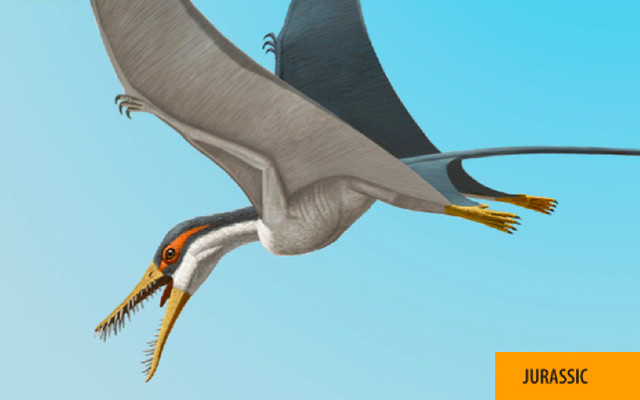Rhamphorhynchus /ˌræmfəˈrɪŋkəs/, “beak snout”, is a genus of long-tailed pterosaurs in the Jurassic period. Less specialized than contemporary, short-tailed pterodactyloid pterosaurs such as Pterodactylus, it had a long tail, stiffened with ligaments, which ended in a characteristic diamond-shaped vane. The jaws of Rhamphorhynchus housed needle-like teeth, which were angled forward, with a curved, sharp, beak-like tip lacking teeth, indicating a diet mainly of fishand insects.
Although fragmentary fossil remains possibly belonging to Rhamphorhynchus have been found in England, Tanzania, and Spain, the best preserved specimens come from the Solnhofen limestone of Bavaria, Germany. Many of these fossils preserve not only the bones but impressions of soft tissues such as wing membranes. Scattered teeth believed to belong to Rhamphorhynchus have been found in Portugal as well.[1]
The largest known specimen of Rhamphorhynchus muensteri (catalog number BMNH 37002) measures 1.26 meters (4.1 ft) long with a wingspan of 1.81 m (5.9 ft).
Contrary to a 1927 report by pterosaur researcher Ferdinand Broili, Rhamphorhynchus lacked any bony or soft tissue skull crest, as seen in several species of contemporary small pterodactyloid pterosaurs. Broili claimed to have found a two millimeter tall crest made of thin bone that ran much of the skulls length in one Rhamphorhynchus specimen, evidenced by an impression in the surrounding rock and a few small fragments of the crest itself.[2] However, subsequent examination of this specimen by Wellnhofer in 1975 and Bennett in 2002 using both visible and ultraviolet light found no trace of a crest, and both concluded that Broili was mistaken. The supposed crest, they concluded, was simply an artifact of preservation.[3][4]
The teeth of Rhamphorhynchus intermesh when the jaw is closed and are suggestive of a piscivorous diet.[1] There are twenty teeth in the upper jaws and fourteen in the lower jaws.[1]
(From Wikipedia, February 2015)




